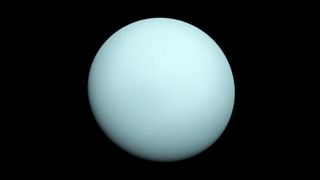Uranus Shines at Its Brightest Tonight: Here's How to See It

You can catch Uranus, one of the solar system's most distant planets, at its brightest tonight.
Uranus reached opposition today (Oct. 28) at 4 a.m. EDT (0800 GMT), which means it is almost directly opposite the sun from Earth's perspective. Not only is the planet's face fully illuminated by sunlight, but Uranus is also closer to Earth now than any other time of year.
The planet was at its closest point to Earth, called perigee, on Sunday (Oct. 27), according to the skywatching site EarthSky.org. For the time being, the planet will be visible all night and will rise in the east during sunset, according to EarthSky. Luckily, the moon just reached its new phase on Sunday and won't wash out the faint planet with a bright sky.
Related: Photos of Uranus, the Tilted Giant Planet
Uranus is visible in the constellation Aries between roughly 8 p.m. and 5:30 a.m. local time, according to In-the-Sky.org. You'll be best able to view it with binoculars or a telescope, but under excellent "seeing" conditions (dark sky, little atmospheric disturbance) it may be just visible with the naked eye. Uranus is shining at magnitude 5.7, at the threshold of naked-eye visibility.
To find the planet, look east for the Pleiades star cluster – a bright, V-shaped collection of stars in the constellation Taurus. Then you can use a mobile stargazing app or sky chart to navigate your way to Uranus. Make sure to bundle up against the cold if you are in more northern regions, and to give your eyes a few minutes to adjust to the darkness of night.

Although Uranus is a large gas giant, it appears so faint because the planet is far away from Earth. On average, Uranus is about 19 Earth-sun distances (or astronomical units) away from our planet, and 20 astronomical units from the sun. Due to its great distance from our planet, Uranus will move only slightly in the sky during the next few months and will rise 4 minutes earlier every day. The gas giant should be visible for several months.
Get the Space.com Newsletter
Breaking space news, the latest updates on rocket launches, skywatching events and more!
- How to See Planet Uranus In the Night Sky
- The Brightest Visible Planets in October's Night Sky
- Dim Planet Uranus Makes a Surprise Appearance in This Night Sky Photo
Follow Elizabeth Howell on Twitter @howellspace. Follow us on Twitter @Spacedotcom and on Facebook.
Join our Space Forums to keep talking space on the latest missions, night sky and more! And if you have a news tip, correction or comment, let us know at: community@space.com.

Elizabeth Howell (she/her), Ph.D., is a staff writer in the spaceflight channel since 2022 covering diversity, education and gaming as well. She was contributing writer for Space.com for 10 years before joining full-time. Elizabeth's reporting includes multiple exclusives with the White House and Office of the Vice-President of the United States, an exclusive conversation with aspiring space tourist (and NSYNC bassist) Lance Bass, speaking several times with the International Space Station, witnessing five human spaceflight launches on two continents, flying parabolic, working inside a spacesuit, and participating in a simulated Mars mission. Her latest book, "Why Am I Taller?", is co-written with astronaut Dave Williams. Elizabeth holds a Ph.D. and M.Sc. in Space Studies from the University of North Dakota, a Bachelor of Journalism from Canada's Carleton University and a Bachelor of History from Canada's Athabasca University. Elizabeth is also a post-secondary instructor in communications and science at several institutions since 2015; her experience includes developing and teaching an astronomy course at Canada's Algonquin College (with Indigenous content as well) to more than 1,000 students since 2020. Elizabeth first got interested in space after watching the movie Apollo 13 in 1996, and still wants to be an astronaut someday. Mastodon: https://qoto.org/@howellspace
